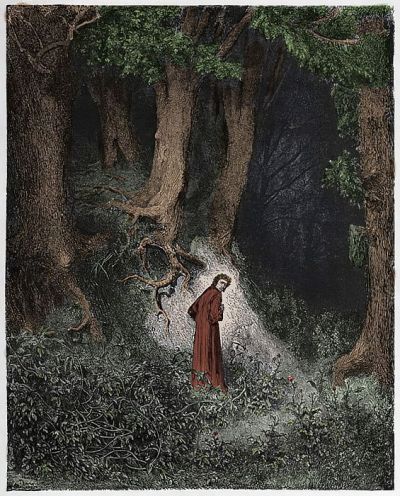“In the middle of the journey of our life, I came to myself in a dark wood where the straight way was lost.” So begins Dante’s journey through the afterlife.
As we see from the above quote, Dante begins by waking. Midway through his life, he came out of a state ‘drugged and loose with sleep’ to a realization he had no idea where he was. Of course, there is more here than a guy lost in the woods. Dante is both physically and spiritually lost. He is having what today would be described as an existential crisis, questioning the meaning and purpose of his life.
The wood itself is more than just a forest. It is a symbol of the world. Imagine being lost in a forest. There are many paths to follow. Which one do you take? So, you choose only to realize that it has led you to a dead end. You try to backtrack. But you don’t quite remember the way back. Add to this the fear. A forest hides many evils. Behind the next bend in the path can be brigands or thieves. Behind the bush ahead might be something that wants to eat you. We can see this reflected in Dante’s life. Throughout his political life in Florence, there were many alternatives from which he had to choose, each with its own risks and opportunities—political enemies who would have gladly eaten him, metaphorically.
As the sun rises, Dante finds his way out of the forest. The canto goes on to say he looks back “as he who with panting breath has escaped the deep sea to the shore, turns to the dangerous water.” Throughout “The Divine Comedy,” we will see references to water. By doing so, Dante parallels the Israelites’ journey from bondage in Egypt to freedom in the promised land. Similarly, Dante’s travels through the nether world is a trip from bondage to freedom. Note that this should not be confused with Dante’s salvation. According to Christian doctrine, one does not earn salvation through works. Salvation, according to the scripture, comes through the completed work of Christ. The purpose of Dante’s experience was to ‘put off the old man’, as Paul would put it. It was a transformative process through which he shed his old nature in which he was bonded to his old habits to a free new nature.
Turning from the forest, Dante sees The Mount of Joy in the morning light. As he attempts to achieve the summit where he can bask in the sunlight, a symbol of divine illumination, he is turned back by three beasts: The Leopard of Malice, The Lion of Violence, and The She-Wolf of Incontinence. These beasts, of course, have a deeper meaning. The spotted leopard represents Florence, a city spotted by two political parties: the White and Black Guelphs. The Lion represents the royal power of France. It is the she-wolf, however, that is the most interesting. The wolf has long represented Rome, recall the famous statue of Romulus and Remus and a she-wolf. Ultimately, it is this final creature that turns him back.
Dante describes the she-wolf as never satiating her appetite and weds with many. Here, Dante is commenting on the state of the Catholic Church centered in Rome. Remember that the Catholic Church of Dante’s time was not the church of today. It was corrupt, embroiled in various political battles to grab temporal power. Later in the canto, it is prophesied that a greyhound will come and throw down the she-wolf. The greyhound was said to be a secular leader who would come and reestablish civil order, uniting a divided Italy under one government. During this time, temporal political power would be taken from the church, and it would be returned to its original mission of tending to men’s souls.
At the end of the canto, Dante meets the shade of Virgil, the Roman poet and author of the Aeneid. Virgil tells Dante that he had been sent to guide Dante through hell and Purgatory, and then another guide would meet them. Dante, who had just about given up all hope, readily accepts Virgil’s assistance. Virgil is selected as Dante’s guide for several reasons. First, Virgil knows the way. In writing the Aeneid, he got to know the underworld. Second, Virgil is Dante’s literary role model. There was no one Dante would have respected more. Third, Virgil is a symbol of human reason. There is a limit to how far reason, Virgil, can take Dante on his journey to freedom. At some point, another must come to complete the process.
Who was it that sent Virgil to Dante’s aid? Why? Who is it that is going to take over for Virgil? We will get the answers to these questions as our story unfolds.



